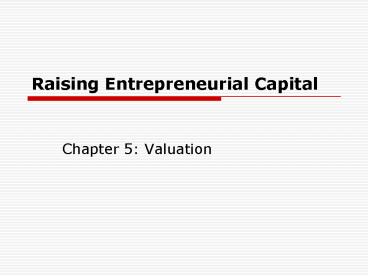Raising Entrepreneurial Capital - PowerPoint PPT Presentation
Title:
Raising Entrepreneurial Capital
Description:
Title: Raising Entrepreneurial Capital Author: John B. Vinturella Last modified by: Erickson, Suzanne Created Date: 5/6/2003 11:10:37 PM Document presentation format – PowerPoint PPT presentation
Number of Views:161
Avg rating:3.0/5.0
Title: Raising Entrepreneurial Capital
1
Raising Entrepreneurial Capital
- Chapter 5 Valuation
2
Valuation Methodologies
- Asset based valuation
- Market comparables
- Capitalization of earnings
- Excess earnings approach, and
- Discounted cash flow (DCF) valuation or present
value of the firm's free cash flows.
3
Finance theory
- would argue that only the discounted cash flow
method is theoretically correct. - the value of any asset is the present value of
cash flows that the asset will generate over its
useful life, adjusted by the risk of achieving
those cash flows.
4
The problem for new ventures
- is that the information that provides the basis
for the free cash flow estimates is generally so
speculative that the more sophisticated DCF
method may not be perceived as worth the effort
it takes to generate a value.
5
Asset-based approaches
- Assume that the value of a firm can be determined
by examining the value of its underlying assets - Liquidation value of the assets
- Replacement value of the assets
- Modified book value of the assets.
6
Liquidation value
- Neglects that part of the firms value that would
be contingent upon the business continuing in
operation. - This does provide a lower bound estimate for a
valuation, however.
7
Replacement value
- Estimates the cost to replace each of the firm's
assets. The value of the business is the sum of
the replacement costs of the individual assets. - Based not on what a willing buyer would pay for
the assets, a market value test, but rather what
it would cost to replicate the company by buying
the assets in the open market.
8
Problems with replacement value
- There are likely to be large discrepancies
between book value and replacement cost for
assets like land, plant and equipment. - Often ignores value adding assets such as human
capital and intellectual property, potentially
seriously understating the value of the business.
9
Modified book value approach
- Assets and liabilities are restated to their
current fair market values. - Items not found on the balance sheet, but that
add to firm value, are included. - On the liability side, the value of any pending
lawsuits or tax disputes are disclosed.
10
Market multiple approach
- Most common method of valuation sometimes called
guideline company approach. - Value of a firm is based on the observed market
value of a comparable company relative to some
metric.
11
Comparison factors
- Capital Structure
- Credit status
- Depth of management
- Personnel experience
- Nature of the competition
- Maturity of the business
12
Valuing service businesses
- Multiples are usually applied to sales or
earnings. - Sales is better for a service business because
sales drive profits and cash flows and expenses
are more controllable than they are in an asset
intensive business. - The implicit assumption is that a certain level
of revenue will result in a certain level of
profit.
13
Discounted cash flow
- Vt CFt (1 g)
- (r-g)
- Vt the value of the firm at time t
- CFt the cash flow at time t
- g the constant growth rate of cash flows in
perpetuity - r the appropriate risk-adjusted discount rate.
14
Appropriateness of methods
- Value a firm from earnings? Some contend that
markets value a firm based on future cash flows,
and not reported earnings. Also, there are many
ways to influence the firm's reported earnings. - Proponents of the market multiple method argue
that companies are more similar than they are
different at various stages of fundraising and
therefore standard multiples can be applied to
companies at each stage of their financing.
15
Capitalization rate
- Inverse of market multiple.
- A multiple of 5 would correspond to a cap rate
of 1/5 or 20. - Cap rates are typically applied to the next
years earnings forecast, and chosen to reflect
the risk of the investment.
16
Excess earnings aproach
- An interest rate reflective of current returns on
tangible assets (plant, equipment, land) is used
to determine a fair return on the business'
assets. - This rate is relatively low, reflecting the low
risk of investing in tangible assets. - The dollar return on tangible assets is
calculated by multiplying the fair market value
of the assets by this risk-adjusted rate.
17
Excess earnings - calculated
- An imputed return is subtracted from the
forecasted normalized earnings for the next year
to calculate excess earnings. - Tangible assets are forecast to return the
risk-adjusted rate for tangible assets. Excess
return is then due to some intangible factor left
off of the balance sheet.
18
Excess earnings - goodwill
- The excess earnings are capitalized at a higher
rate than the rate on tangible assets to
determine the present value of the company's
goodwill. - The sum of the present value of goodwill and the
firm's tangible assets equals the total firm
value.
19
Problems in implementation
- Excess earnings, cap rate and DCF methods all
require the use of a risk-adjusted discount rate.
- The excess earnings method requires the use of
two risk adjusted rates which doubles the
opportunity for error in the valuation.
20
Free cash flow valuation
- Defines the value of the firm as the present
value of the expected future cash flows in excess
of those needed to operate the company. - A firm's economic or intrinsic value is then
equal to the present value of its free cash
flows discounted at the companys cost of
capital, plus the value of the firms
non-operating assets.































